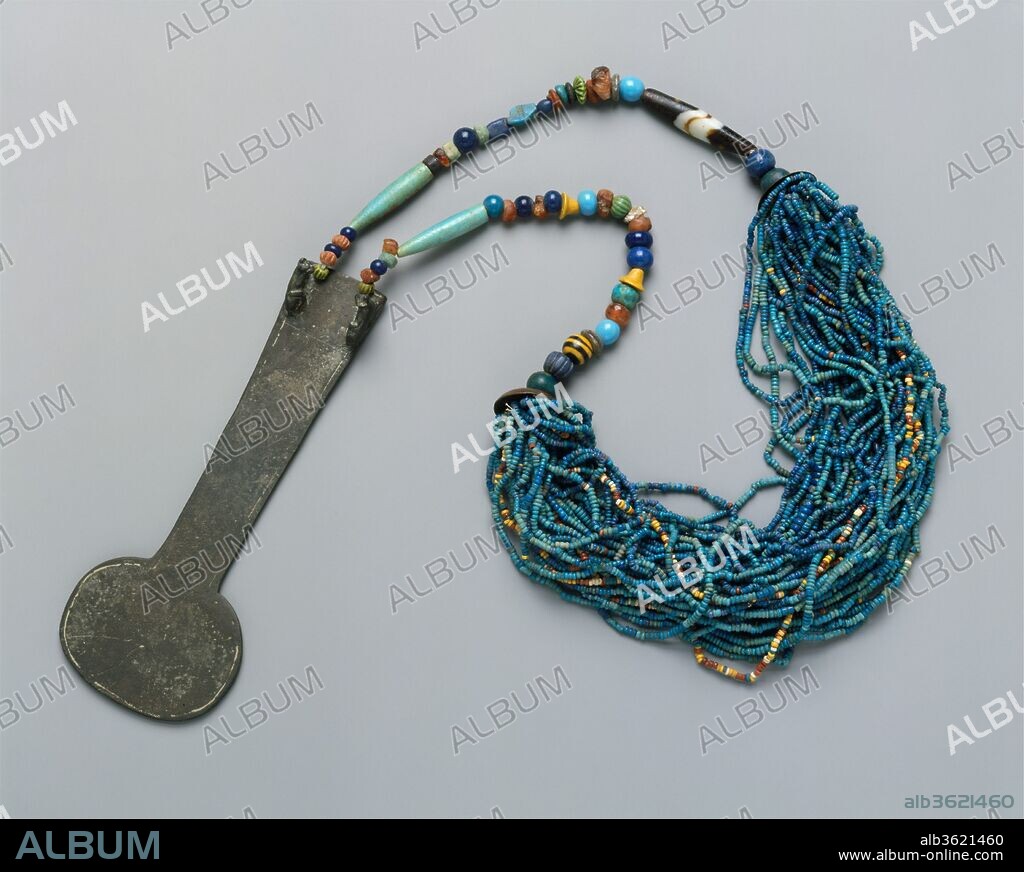alb3621460
Menat necklace from Malqata

|
Zu einem anderen Lightbox hinzufügen |
|
Zu einem anderen Lightbox hinzufügen |



Haben Sie bereits ein Konto? Anmelden
Sie haben kein Konto? Registrieren
Dieses Bild kaufen

Titel:
Menat necklace from Malqata
Untertitel:
Siehe automatische Übersetzung
Menat necklace from Malqata. Dimensions: L. of counterpoise 14.7 cm (5 13/16 in.). Dynasty: Dynasty 18. Reign: reign of Amenhotep III. Date: ca. 1390-1353 B.C..
A menat necklace consists of a heavy, keyhole-shaped counterpoise (menat) and many strands of beads. Although the necklace is sometimes shown being worn (fig. 2 above), it was more often carried by females participating in religious ceremonies. It functioned as a percussion instrument that was shaken to create a soothing noise that was thought to appease a god or goddess. In the New Kingdom the menat necklace and sistrum (68.44) were attributes of women who held the title "Singer of Amun-Re" such as Renenutet, who is depicted holding her menat on her lap in a statue.
In the early 20th century, the Museum conducted excavations at Malqata, a site at the southern end of the Theban necropolis where Amenhotep III had built a festival city for the celebration of his three jubilees (or heb seds). This miraculously preserved menat necklace and two single-strand necklaces of beads and amulets were found in the corner of a room in a private house near the King's Palace. According to the excavators, the three necklaces had been placed in a linen bag, traces of which were still visible.
Technik/Material:
Faience, bronze or copper alloy, glass, agate, carnelian, lapis lazuli, turquoise
Zeitraum:
NEW KINGDOM
Museum:
Metropolitan Museum of Art, New York, USA
Bildnachweis:
Album / Metropolitan Museum of Art, NY
Freigaben (Releases):
Model: Nein - Eigentum: Nein
Rechtefragen?
Rechtefragen?
Bildgröße:
4192 x 3354 px | 40.2 MB
Druckgröße:
35.5 x 28.4 cm | 14.0 x 11.2 in (300 dpi)
Schlüsselwörter:
ACHAT • AEGYPTISCHE KUNST • AFRICA • BRONZE • CHALZEDON • EGIPTO • FROM EGYPT, UPPER EGYPT, THEBES, MALQATA, BIRKET HABU MOUND B 1, PRIVATE HOUSE B, MMA EXCAVATIONS, 1911-12 • HALBEDELSTEIN: KARNEOL • KARNEOL • KUPFER • METROPOLITAN MUSEUM OF ART, NEW YORK, USA • OBERÄGYPTEN • THÈBES • ÄGYPTISCHE KUNST
 Pinterest
Pinterest Twitter
Twitter Facebook
Facebook Link kopieren
Link kopieren Email
Email
